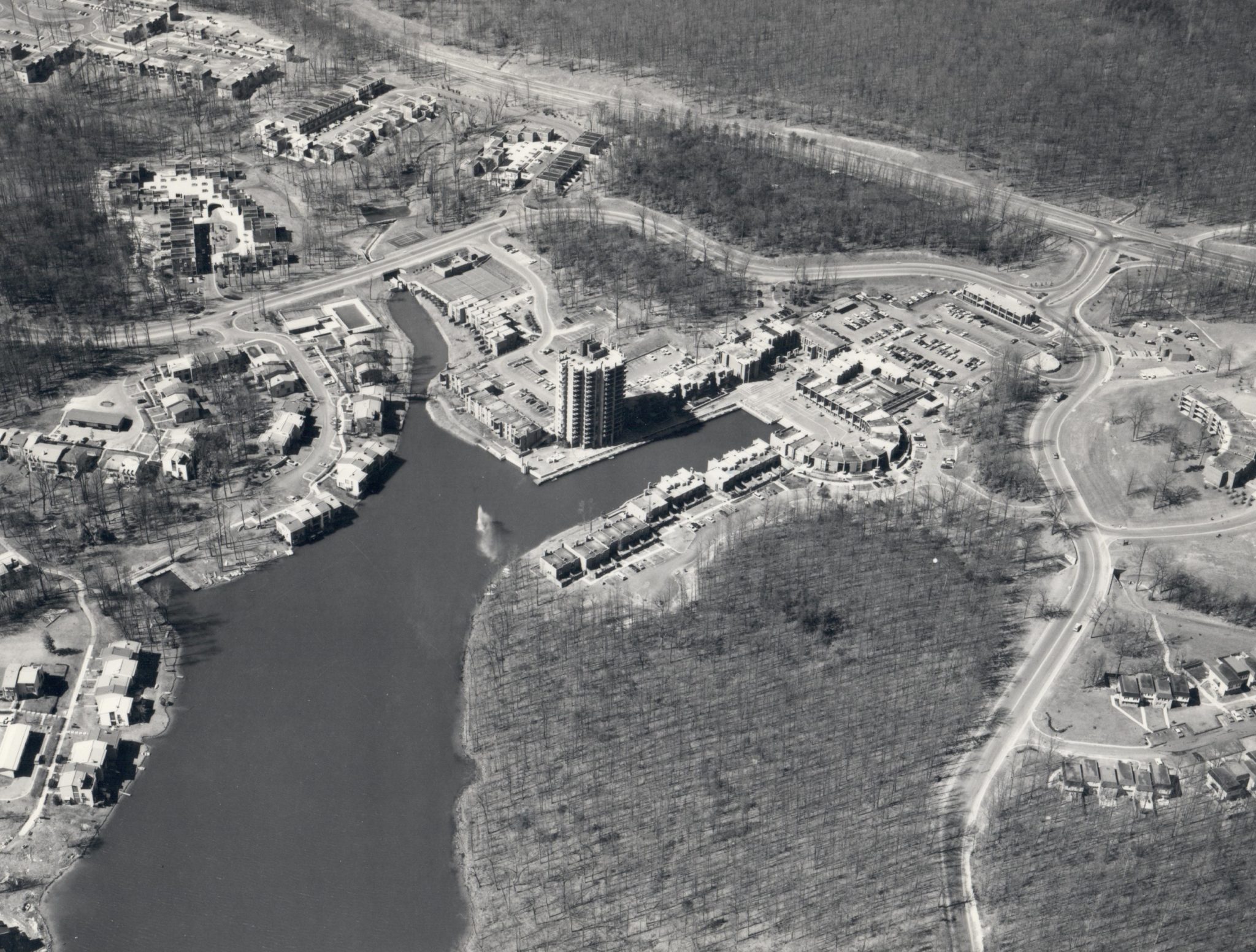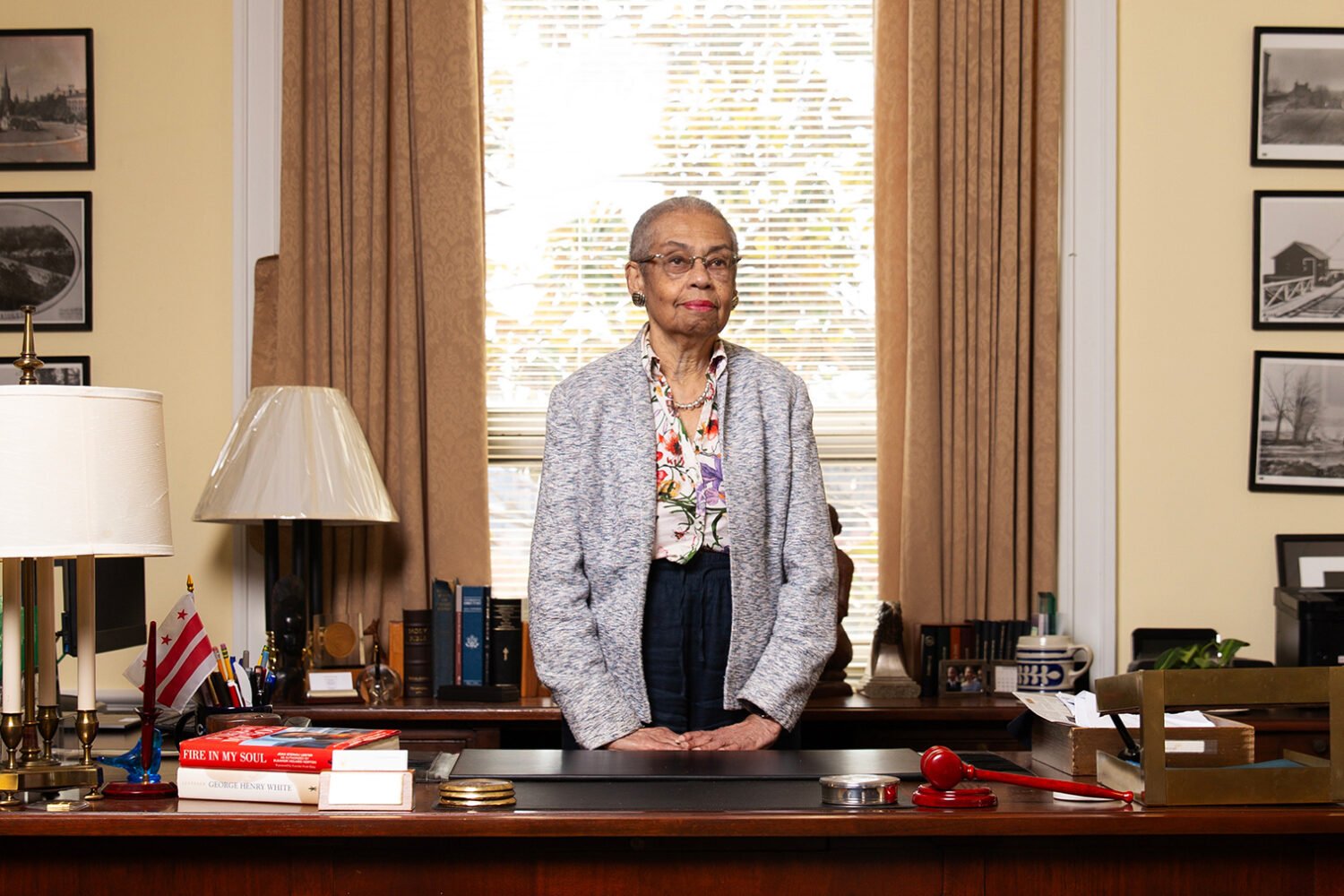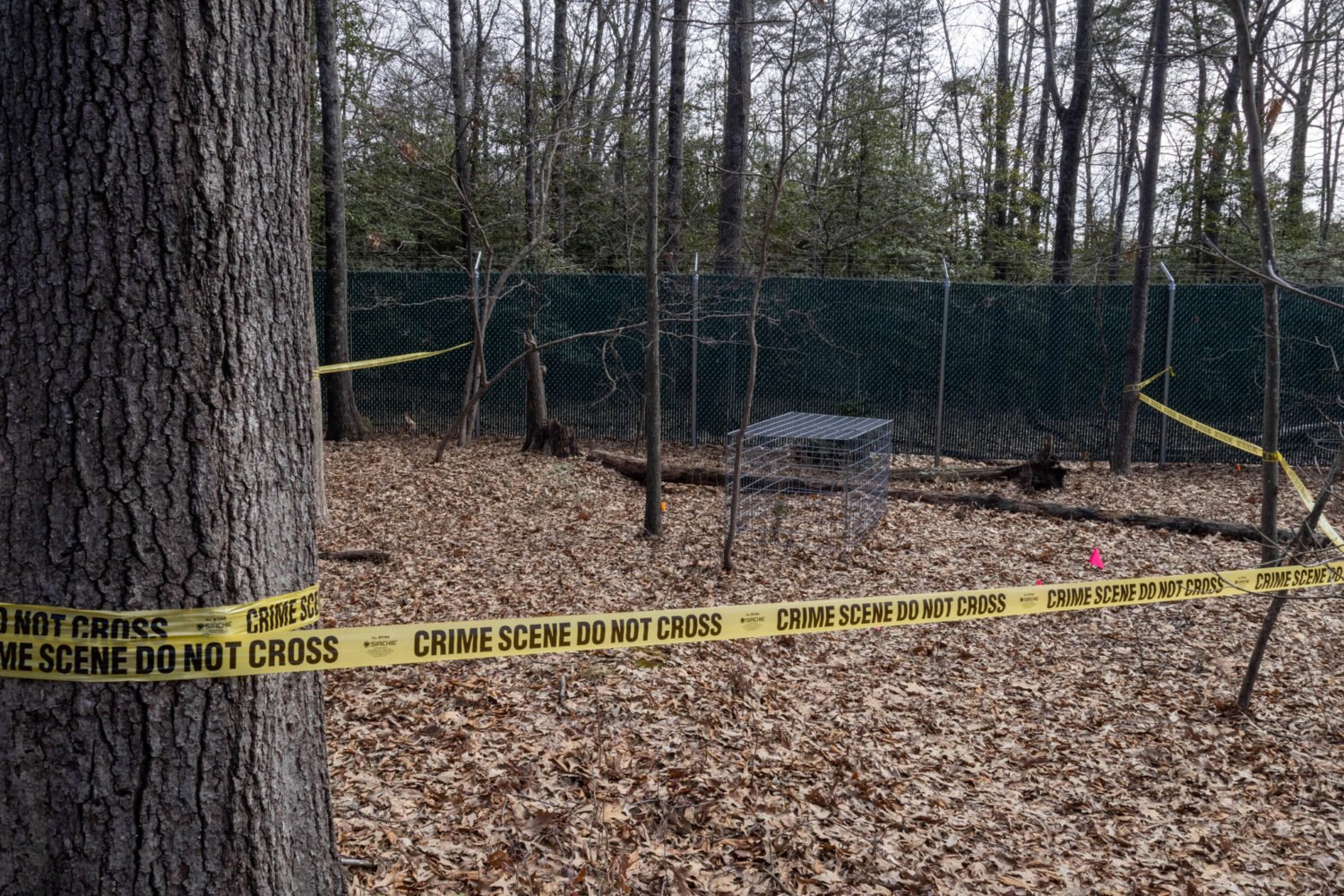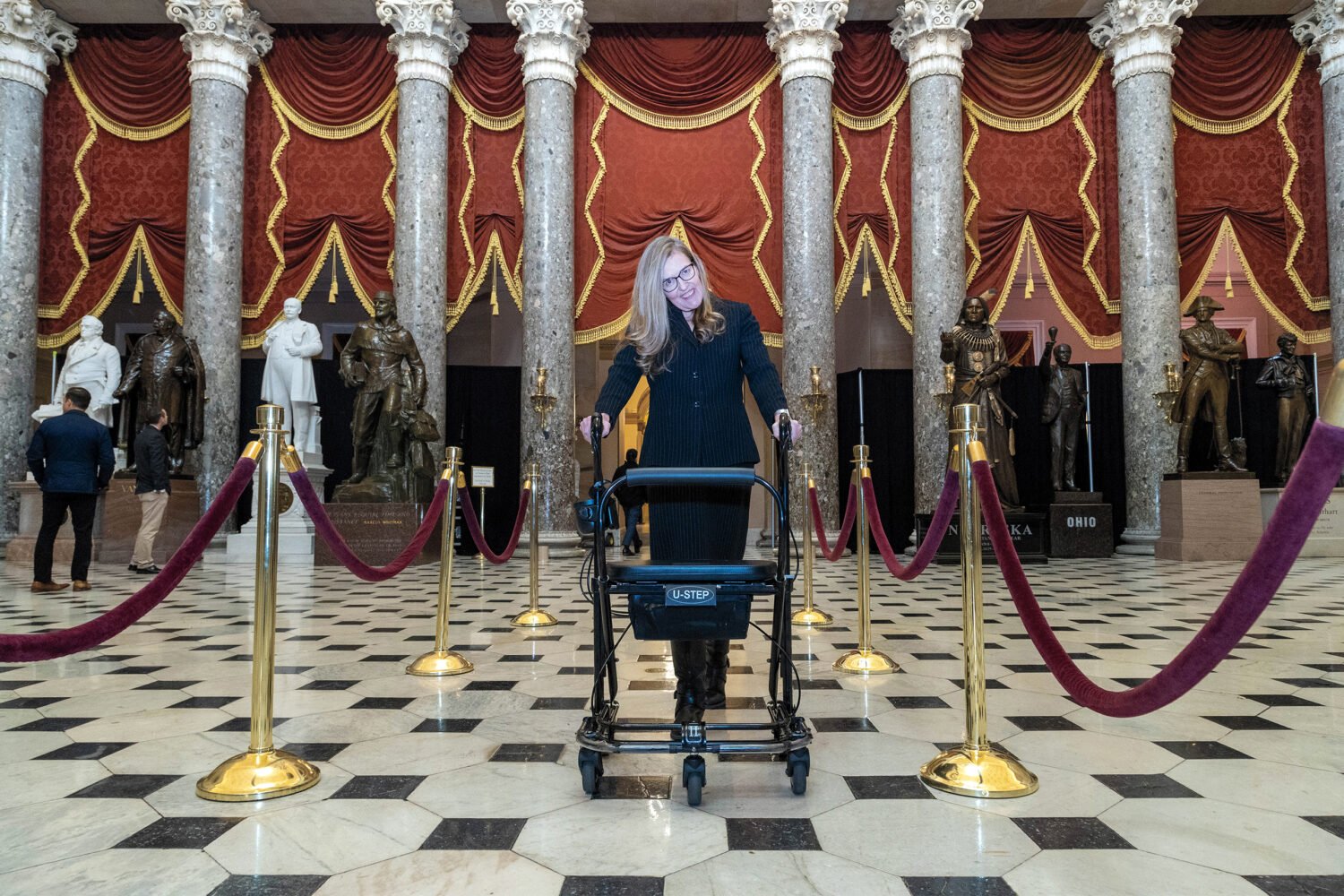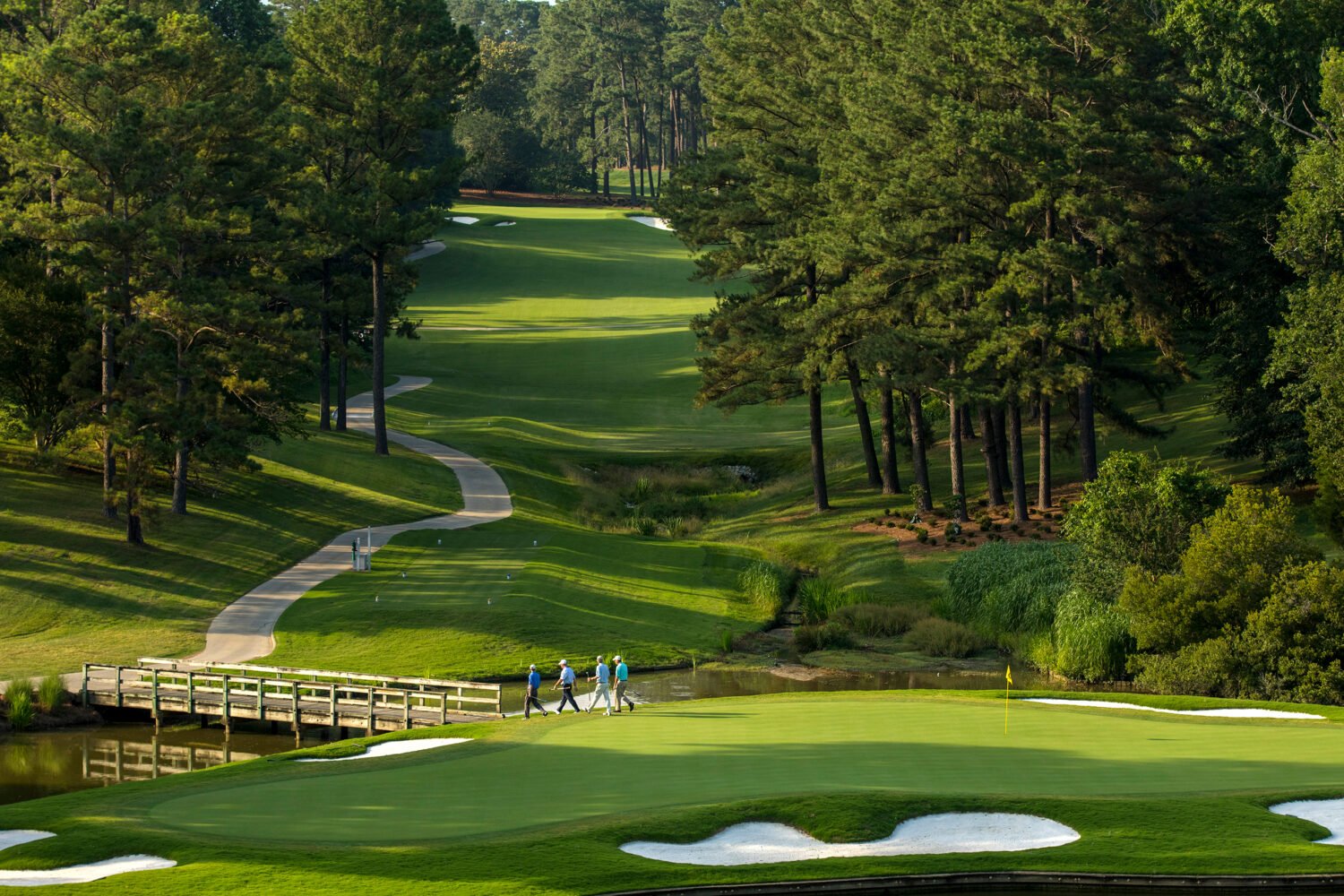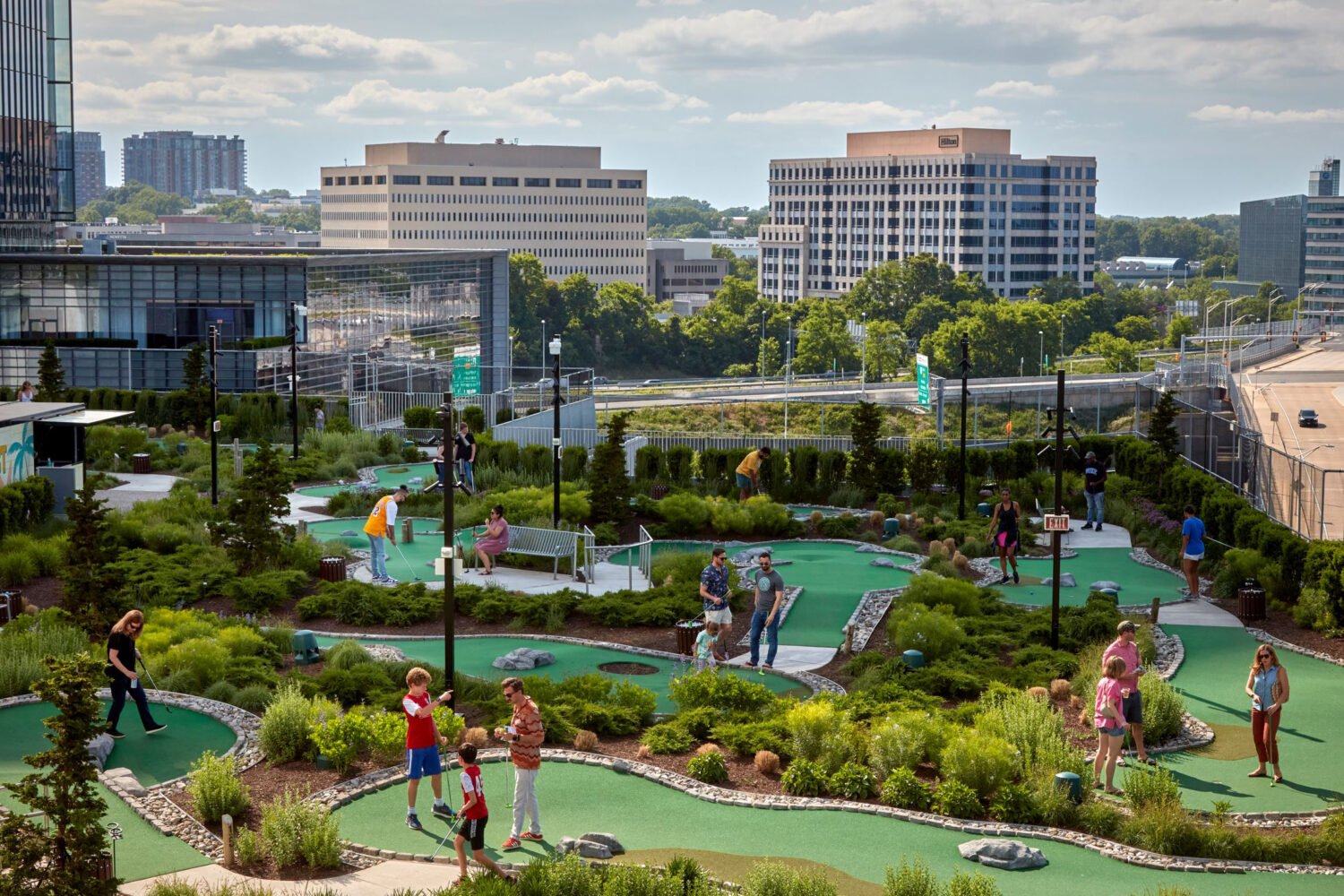Looking back on it, the night 900 people marched into South Lakes High School was probably the moment when things got out of hand in Reston. There was the preposterous number, for one. And how most of them came dressed for combat in bright-yellow T-shirts. Nine hundred fired-up citizens descending on a municipal meeting, demanding to take back their town, fighting for all that was good and righteous. And also, ostensibly, golf.
It was an October night in 2017, and the agenda concerned an existential question: Should the town of 60,000 pack in more people, in essence expanding the population?
The forces blowing through the room—class, generational politics, race—were no less portentous. Reston, founded in the 1960s as a liberal, civic-minded utopia, had not changed. But the region had. Greater Washington was now one of America’s richest and priciest metropolitan areas, a place where middle-class families were newly daunted by real-estate prices. And still more newcomers were pouring over the hills, lured by a swell of tech and other white-collar jobs. In Reston, the powers that be had tried to link their fate to the city. A Metro station was built. A new “master plan” envisioned the town becoming fashionable and built up. New townhouses and apartment complexes would relieve some of the inexorable upward pressure on housing costs. A citified layout would correspond to the pedestrian-friendly, urbanist tastes of a new generation of DC-area intelligentsia.
All that remained was the town’s buy-in.
What followed was a harmonious concord of good faith on all sides, evidence of the enduring comity for which Reston continues to be famous.
Just kidding. It’s been a fiasco—a rambling, wide-ranging dispute marked by bureaucratic false starts, allegations of manipulated photos, and the widespread belief that Reston as we knew it is slipping away.
That night at South Lakes High, the frustration boiled into furor. The Yellow Shirts—this is indeed how Restonians refer to them—had formed ranks, an alliance of mostly older homeowners, to oppose an increase in density. But this was not quite a civics lesson. It was closer to a blitz. Within four minutes of questions and answers, the crowd began booing the Fairfax County officials pitching the plan. There was a frenzy of accusations, recriminations, even an allegation of bribery. The county was going to ruin Reston! As the Yellow Shirts shook a sea of multicolored placards, the room convulsed like a geriatric day-glow rave.
In such moments, it was hard to believe that the matchstick that had lit this particular dumpster fire, years before, was golf.
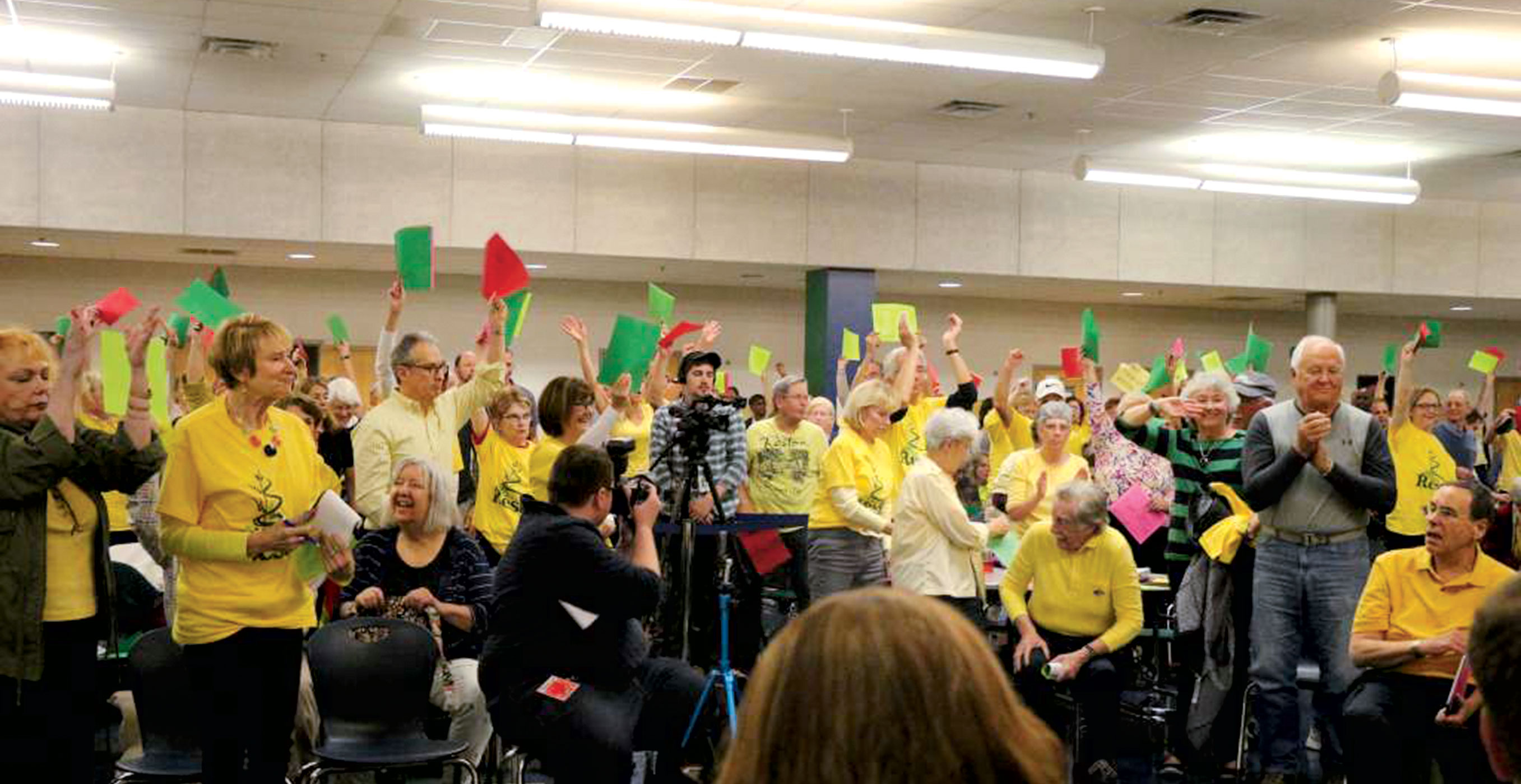
For some five decades, Restonians have enjoyed two golf courses. But in 2012, with Metro’s arrival two years away, the owners of Reston National attempted to develop the public course. Among the town’s aging boomers, this unwelcome surprise had roughly the mobilizing effect of the assault on Fort Sumter. A passel of groups—Rescue Reston, Reclaim Reston—began proselytizing, spreading Gothic visions of a half-golfless future. One group printed lawn signs spelling out their case in barefaced terms: $1,000,000 view or 1,000+ houses?
Whatever the placards lacked in subtlety, the slogan is doubtlessly accurate, one that encapsulates the dilemma faced by Reston and so many other places around the region: On the one hand, the bucolic present. On the other, the mounting pressure to alter the supply-and-demand equation that is pricing out the sort of homebuyers who were once the core of the town.
You may be well versed in this debate. “What you’ve got in Reston, and really everywhere in suburban America, is a demographic shift that’s occurring. The dominant baby-boom generation ages and expires, and the newer, younger generations look different—they have different interests and different incomes and different commuting patterns,” says Patrick Phillips, former CEO of the Urban Land Institute, who has studied Reston. “These sort of little battles”—bike lanes versus parking lots, open spaces versus outdoor shopping malls, high-rises full of two-bedrooms versus fairways framed by cherry trees—“are fractious,” Phillips says, “but they’re inevitable, too.”
Yet Reston is not just Suburbia USA. It was dreamed up by a real-estate scion named Bob Simon, who sold his family’s stake in Carnegie Hall to build a new kind of American town. Repulsed by Levittown—known for its mass-produced housing and codified racism—Simon created a founding document with seven principles that enshrined egalitarian values into Reston’s soul and its zoning code. The town would contain ample opportunity for leisure and exposure to nature but also a tableau of diversity in age, income, and race—one of the first fully integrated communities in Jim Crow Virginia.
This was no typical town, and no typical NIMBY battle. How did it happen?
Reston’s founding, in 1964, was a national news story. The Chicago Tribune called it “The City of the Future.” For decades, the town largely lived up to its aspirations. Its crown jewel, Lake Anne, was a model of architectural ingenuity, braided with apartments and single-family homes, restaurants and shops, and kayaks for rent by the hour. By 1980, Reston was both more racially diverse and more affordable than Fairfax County. In a story that’s become enshrined in Restonian lore, townspeople rallied to move a homeless shelter inside the municipal limits.
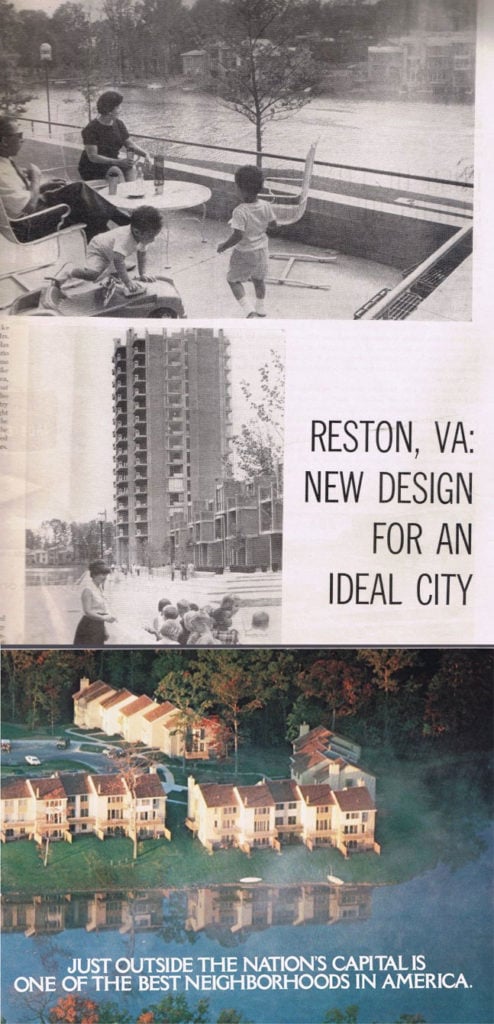
Lately, though, the town has followed the familiar arc of an aging suburb. Since 2000, according to Census data, the number of children has fallen by nearly 10 percent. Reston is now 17 percent whiter than Fairfax County. And affordability has become more elusive: Since 2010, the number of household incomes of $200,000 or greater jumped by 59 percent while the median home sales price rose about 25 percent.
This conundrum had ensnared people such as 32-year-old Canaan Merchant, who moved to Northern Virginia for college. He and his wife had their first daughter in 2014, their third child four years later. He put aside his English degree and found a job as a computer programmer. The pay was good, but it’s no longer good enough. Merchant—who blogs in favor of more growth—has been renting in town for the past couple of years and badly wants to buy, but he’s realized that his family will have to leave. “It’s strictly a pure shelter thing,” he says. “There’s no way I can afford a single-family home in Fairfax County.”
County planners looked at this problem not just sympathetically but economically: They wanted Merchant, his programmer salary, his tax dollars, and most of all his kids to stay. If that necessitated more housing, it meant less open space, which meant fewer cars, which meant more public transit, more crosswalks, taller buildings. The master plan imagined extensive growth; it gave no figures, but some worried the population might double. Suddenly, a golf course looked like a hell of a luxury.
But to residents who had invested their lives in Reston’s sylvan charm decades ago, this vision was heretical. When the backlash came, it was large, organic, and swift. “The county did not know how to handle it, 900 citizens coming out,” an activist named Dennis Hays told me this summer, with a gleam in his eye. “That’s not including the people who couldn’t find a parking space within a mile.”
Hays—who prefers to go by “reactivist”—was once ambassador to Suriname and wears a realist’s taut smile. He had invited me to a lakeside lunch with Lynne Mulston, a marketing executive who arrived in her electric-blue golf shirt and, with her hawkish features, called to mind Margaret Thatcher at the LPGA. Two of the Yellow Shirts’ most polished spokespeople, Hays and Mulston had helped stop the would-be redevelopment of Reston National seven years ago but stayed on guard for a new encroachment against it or against Hidden Creek, the private course in town. Or, for that matter, anything else.
Since Metro arrived, Hays explained, traffic had become impossible, schools got crowded. As the county forged ahead with its plans, the Yellow Shirts saw each new rendering of an urban promenade or pocket park as a threat to their town’s character. They weren’t unsympathetic to Merchant’s dilemma—they just didn’t believe condos would fix it. (Were those really what a thirtysomething couple with three kids and a goldendoodle would want?) Also, the high-rises were ugly. “Azkaban Prison” and “Moscow Towers,” Hays called them.
Even if you were still lucky enough to have your backyard border one of the golf courses—as Mulston’s does—your view had been affected. For Hays, it was all too much. “You wake up one day,” he told me, “and say, ‘Wow, what happened?’ ’’
Where the Yellow Shirts saw a passionate campaign for a beloved course, their opponents saw an elaborate pretext for fighting development. “I hear these people bitching and moaning, saying, ‘We’ve got to keep Hidden Creek!’ ” a longtime Restonian named Bill Bouie told me one afternoon over coffee at the Town Center. The Yellow Shirts, he complained, had taken NIMBYism “to a whole new level.”
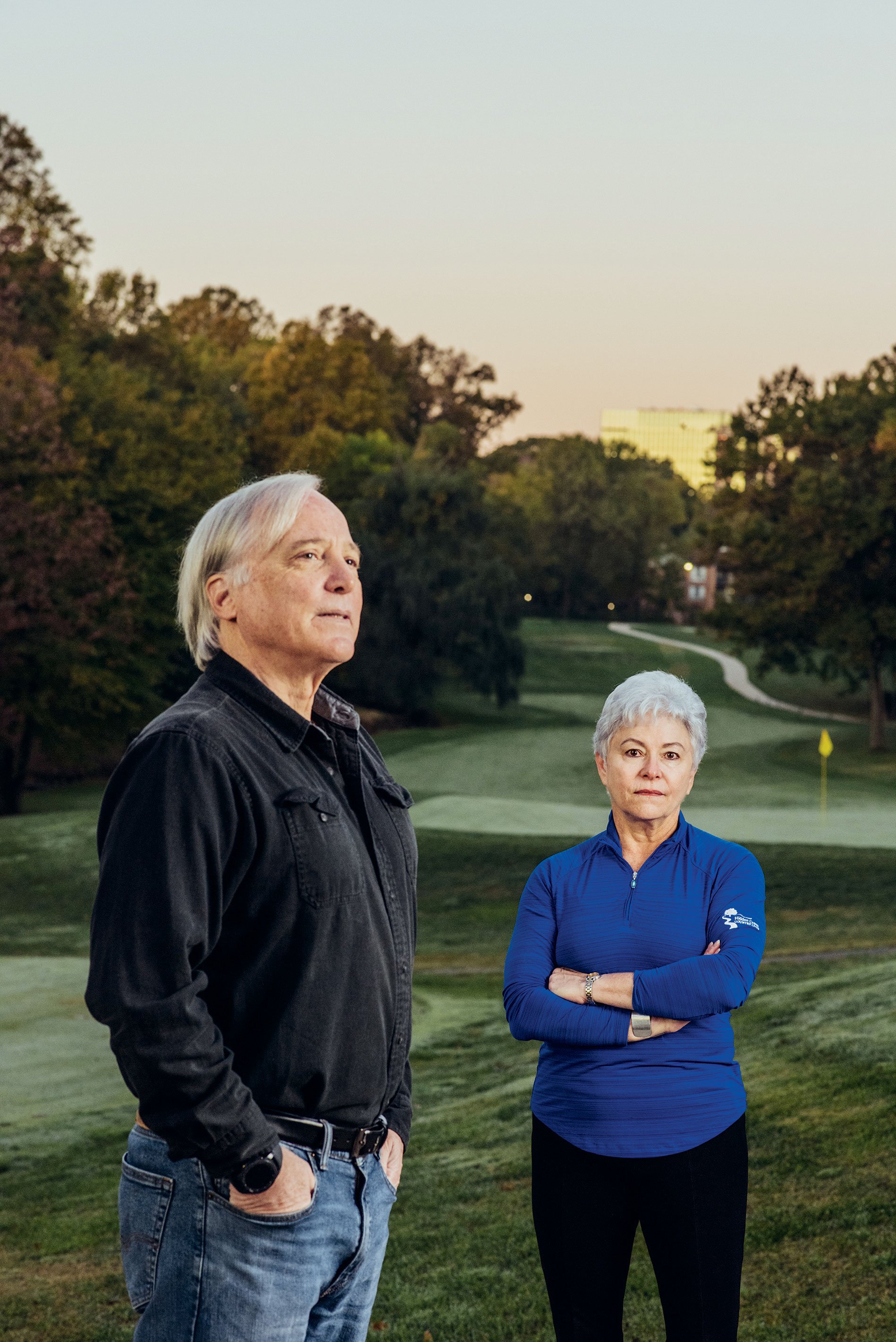
Bouie is an official in Fairfax County’s parks department but since 1985 has lived in Reston, where he discovered a rare middle-class enclave welcoming to African Americans like him. Sixty-six and towering, he lives almost a parody of a park official’s private life—he has four gold medals from the Senior Games and a spot in the Michigan Softball Hall of Fame. If anyone was zealous about green space, it was Bouie. Why not build some affordable housing on the land and keep the rest as a public park, he asked—wouldn’t that be more in line with Bob Simon’s values?
“If we want to maintain Bob’s ethos and not look like Vienna or any other suburb, we need to take control of that now,” Bouie warned. The alternative is “people coming in, tearing down existing homes, and throwing up these McMansions. Then every house is a seven-figure home.”
At any rate, he claimed, golf participation in the county is way down. The next generation just isn’t as into the game. “I’ve got the reports,” Bouie said. “Golf courses are going away.”
Were they?
After our lunch, Mulston introduced me to another partisan, a property manager named Connie Hartke. Hartke opened her laptop and flashed a picture of the Reston fairways. “It’s not just golfers who enjoy these courses—much as our opposition tries to portray that: ‘Oh the elite, the elite golfers,’ and all this nonsense,” she said. “Runners. Birdwatchers. All sorts of people.”
Mulston nodded: “Both golf courses are essential elements of Reston. They really are.”
“It’s not that we’re hoity-toity. Oh, no. We’re very liberal. Very progressive. Very accepting.”
So what about Bouie’s “reports”? Horse hockey. “Everyone’s going to try to spin you,” Mulston said. “Uptake of golf is actually increasing. A lot of that is the advent of Topgolf”—the trendy, party-oriented driving ranges—“that’s really helping to grow the game of golf.”
We then moved to a survey of golf arcana: Did I know golf was a way to connect with nature? That it teaches kids real social interaction? That it’s where much of American business gets done? To underscore their point, the activists introduced me to Sudha Gummuluru, a woman working in Hartke’s office building who was part of a Topgolf team in Ashburn. So—had Gummuluru and her family ever been to the Reston golf courses? Actually, no, she told me. Hartke furrowed her brow slightly at the confession, noting that golf teaches youngsters discipline and honor. Gummuluru tepidly suggested she would take her son to the course sometime, then slipped out. Hartke turned to the table: “Is golf dead? No, it is not.”
By now, I had learned plenty about the merits of golf but not as much as about what I’d come to hear: Who is Reston for?
To that sect of the Yellow Shirts, who insisted they were not entirely opposed to growth, the fight was about preservation of idyllic values. But at the core of the movement, sentiments about Reston’s evolution were more inflamed. “It’s not even hardly recognizable!” complained Tammi Petrine, one of the earliest activists. “If I could think of another place to go, I would. Because this is a shitshow.”
We were sitting at Petrine’s long kitchen table, which had served as the Yellow Shirts’ early war room. Petrine, who settled in Reston in 1976, has long since retired from doing project management for a construction company—this is her day job now. She staked her position in categorical terms: “You want urban, and we want suburban. You can’t have urban. We came here for suburban.”
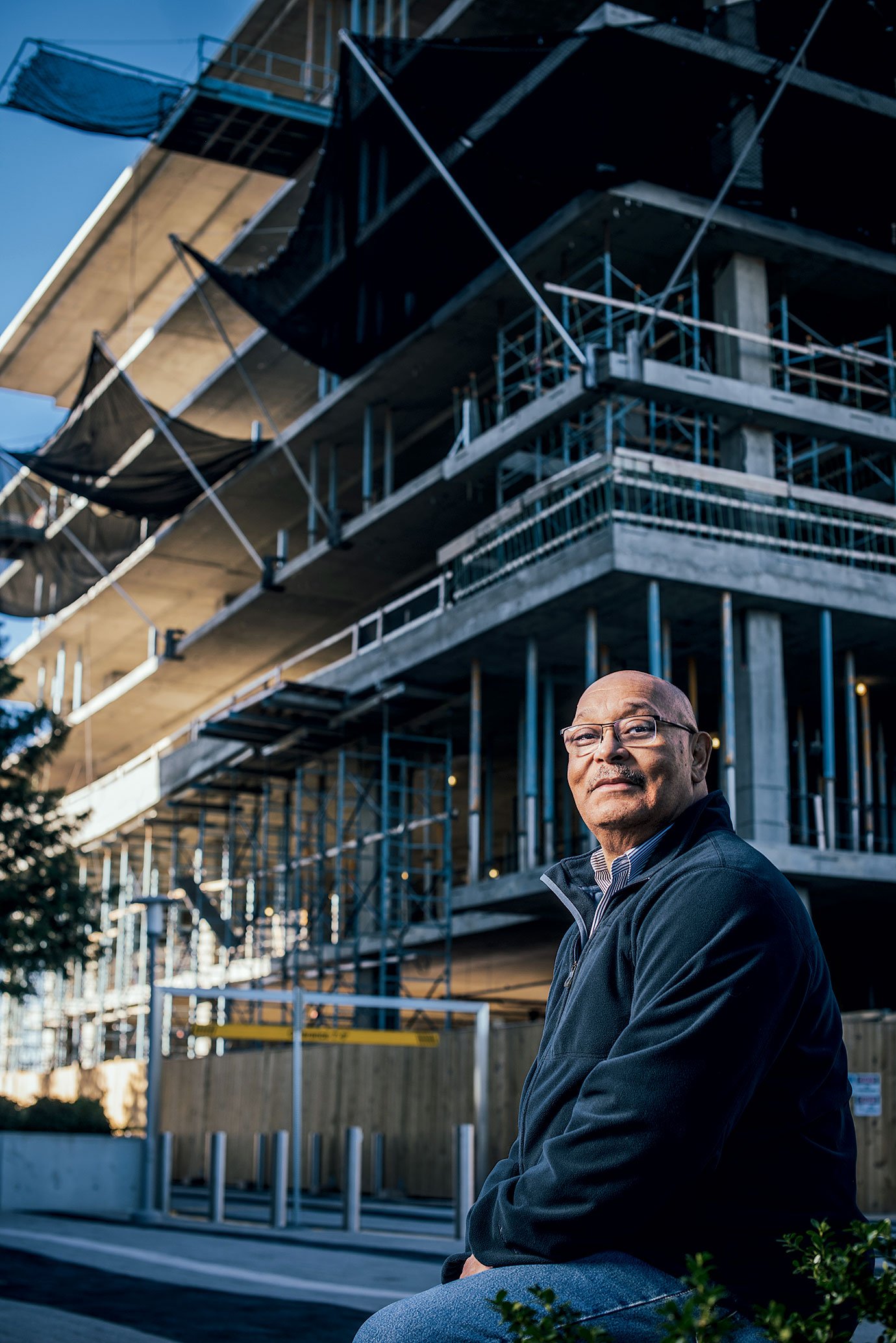
In Petrine’s eyes, the problem was that anyone had sought to bring Metro to Reston at all. The list of turncoats was vast: the county for putting its grubby hands on the town, Metro for spreading through the county, Lyndon Baines Johnson for conceiving Metro. There was a whiff of conspiracy. “Metro was put in as an excuse to develop Reston,” Petrine told me, citing a trusted source on the Board of Supervisors. “I’ve been saying the same thing, and branded as a criminal and a traitor.”
Her opposition wasn’t founded so much on airy appeals to Simon’s vision but on math. “You can only stuff so much in a given space. We’re over,” she declared. The meaning seemed clear: Reston was full.
This was the bugle call that had marshaled 900 fuming Yellow Shirts to South Lakes High. But it was also the emotional fulcrum of their opponents, who saw the very idea as an assault on the soul of their town.
At the end of the raucous meeting that night, the crowd heard from Cathy Hudgins, Reston’s elected supervisor to the county board and its only person of color. She reminded them that Reston had been an oasis of inclusivity for people like her, who grew up in segregated Virginia. Should younger people, poorer people, be denied the chance to live there? “I can tell you, if that’s what you believe, it’s not Bob Simon’s dream that you’re talking about,” Hudgins said solemnly, to a few boos in the crowd.
The Yellow Shirts may have blanched at Hudgins’s version of history, but in the rhetorical effort to link causes with the sainted Bob Simon and the Gospel of the Seven Principles, the two sides were exactly the same. Everyone seemed to tout his or her ties to the man. “I was a good friend of Bob’s,” Bouie assured me at one point. “We have a pretty good idea of what Bob was thinking.” Mulston and Hartke, meanwhile, showed me a quote of Simon’s, saying: “The Reston National Golf Course area should remain as open space forever.”
“Cranky old white people. There’s no diversity in that group.”
It was as if sectarian visions had collided under the banner of their provincial patron saint, a religion that had cleaved somewhere in the ninth century. “Those resisting affordable housing can also embrace other goals Simon had, like open space, architectural quality—whatever they want to rest their case on,” Phillips, from the Urban Land Institute, says. “There’s an ideology that everybody can grasp onto. Kind of like the Bible.”
So had Hartke been close with Saint Bob? Not exactly. She had apparently telephoned him and secured the quote one day in 2015, when he was 101. “And thank God I did,” she beamed, “because a few months later, he died!”
When I presented the evidence to Bouie, he snorted with pity. As any actual friend of Simon’s knew, Simon would never have endorsed golf. “He was a tennis guy,” explained Bouie.
“Oh, God,” said Mulston when I mentioned Bouie, throwing her eyes to the sky.
“Bouie, he has a problem,” her ally Hays explained: Bouie works for Fairfax’s Park Authority, which wants more parks. Annexing the golf courses, Hays went on, “solves his problem.”
Occasionally, baser outlooks revealed themselves, and on both sides. “Why aren’t there a lot more high-rise developments in Georgetown?” Hays asked. “Basically, people who live there, work there, had the clout, to say, ‘You know, no: We’re not going to tear down 170 townhomes and put up a 14-story building.’ ” Arlington, too. “They don’t do that. Why not? They’re established neighborhoods. Well, we’re in an established neighborhood. Why do we have to carry this load?”
Bouie was willing to see the worst in this admission. “When they’re saying they’re against Metro, they weren’t thinking about people from Reston going to DC. They were thinking about people from DC coming here,” he said. “Cranky old white people,” Bouie sniffed. “There’s no diversity in that group.”
This was one allegation Petrine would not abide. “We don’t want minorities or young people or poor people here? What, are you f—ing kidding me?” she retorted. “It’s not that we’re hoity-toity. Oh, no. We’re very liberal. Very progressive. Very accepting. We’re anything but elitist,” Petrine explained. “Age, color, economic. We don’t care: Anybody is welcome.
“But,” she warned, “don’t f— us over.”
If anyone could referee the match, it was a member of the pioneer generation, that ’60s-era cohort who had landed when Reston was less like a suburb and more like an experiment. This is how I found myself in the office of Chuck Veatch, a developer who’d been one of Bob Simon’s first salespeople.
“I don’t want to be a focal point or note of controversy,” Veatch made clear immediately. “I have been a beneficiary of all that is Reston.” Even so, he had concerns.
Veatch’s job in the Reston sales office began in 1964, right after he graduated from UVA and before any residents moved in. “We were tasked with convincing people to come way out here in the middle of nowhere and invest in a community that was iffy—whether or not it would survive,” Veatch said. Often, prospective homebuyers marched into the sales center and demanded to know whether the town would sell homes to non-whites; Veatch could never distinguish bigots from racial progressives, so he just told everyone the truth.
In the five decades since, he’d never seen such acrimony. The Yellow Shirts were correct that more density everywhere was unnecessary but were uncivil about it—“Right for the wrong reasons, and expressing it horribly,” he said. But the pro-density contingent was correct that, generally speaking, more development went hand in hand with the Metro and that both were central to Reston’s success in 21st-century Washington. “Bob Simon was not afraid of density. But! But!” he interrupted himself, circling a map of the town with his finger. “It was density for a purpose. And that means along the Metro.”

He chided the competing caricatures of Reston that had taken root in the haze of infighting, either a municipal kibbutz or a gated hamlet in Mar-a-Lago. “It’s not a socialist utopia,” he chuckled. At the same time, the Yellow Shirts misunderstood that “the success of the community is not about how much money your house is worth.” Amid the partisan bickering, everyone had misplaced something elemental: the town’s shared sense of community, a distinct virtue in the face of the booming metropolis surrounding it. “Bob started out by weaving the social fabric of Reston first,” Veatch said.
To save Reston as Bob Simon imagined it, the community would have to find some compromises. Veatch pointed out one of his recent projects—a hip-looking apartment complex smack across from the Metro. He had voluntarily added several affordable units, even though it was less profitable, and made certain every unit was exactly the same—so no one would feel singled out, he said, for being lower-income. For Veatch, this element of service “is what the soul of Reston is about.”
Maybe so. But such compromise seems unlikely for now. Earlier this year, the Yellow Shirts claimed their biggest scalp yet, when the county announced it was putting its density plans on indefinite hold. The master plan is now as contested as ever. One of the ironies of this outcome is that developers can continue to buy where they can, as fast as they can. “A trainwreck,” Veatch said.
In the absence of consensus, each new development is becoming a symbolic, piecemeal battle about Reston’s identity—all over again. And the Yellow Shirts, if they didn’t exactly welcome this new phase, seem ready. At our last meeting, Hays, the former ambassador, flipped his phone over the table and showed me the website for Rescue Sunrise Valley. It’s a new citizens’ group, opposing a proposed development—not along a golf course but near the Metro. “They’ve got a website, flyers, bulletins, information sheets,” Hays noted proudly. They were meeting Saturday. Did I want to go?
This article appears in the December 2019 issue of Washingtonian.
